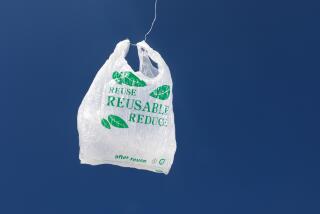Solvents Take Us to Cleaners
- Share via
In “How to Get Clothes Clean?” (Oct. 21), Jon Meijer, vice president of the International Fabricare Institute, calls perchloroethylene “fabulous” for its ability to remove stains “without damaging fabric.” It must be a peculiar luxury to put clothing ahead of people’s health and safety. As the son and grandson of dry cleaners, I am relieved that action is underway to eliminate this chemical. This work should have begun a generation ago, when health agencies first spotted the carcinogenic trail of “perc.” The National Institute for Occupational Safety and Health advised workers to treat the chemical as if it were a carcinogen as early as 1978. I see nothing fabulous about perc.
My father died in 1993 of kidney cancer linked to perchloroethylene exposure. Will multibillion-dollar chemical corporations and the trade associations they support delude another generation of mom-and-pop dry cleaners into complacency, illness and death?
Scott Vineberg
Santa Monica
*
I’m glad to hear that our air-quality regulators are moving to rid our communities of this pollutant. If dry-cleaning prices rise as a result, it is necessary to create a more efficient economic system that more closely aligns the true cost of dry cleaning with its total cost to society. If some dry cleaners are forced to go out of business, then it is in the name of a more efficient economic system. Like tobacco and other toxins, perc is a dangerous substance that should not be paid for by society at large.
Ruben Serrato
Santa Monica
*
I am a second-generation dry cleaner who has worked in the industry since I was a child. As a 28-year-old businessman, I own a dry-cleaning plant and have studied this business and all aspects of the industry. My family came here in 1979, from Iran, with my father having master’s degrees in both chemistry and metallurgy. Regardless of his degrees, owning a small business was the only way we could try to obtain the American dream.
The 350 people or so who have voiced their disagreement at the banning of perc are a small fraction of the voices out there. In the past 50 years, the dry-cleaning industry has improved dramatically, and machines today are 10 times more efficient than 15 years ago. The amount of toxins you inhale when you pump your gas in one day are far more dangerous and hazardous to your health than having your clothes cleaned in perc for a year.
When it comes to cleaning quality and price, there is no possible way you can compare perc to the other options, such as silicone and hydrocarbons (which are hazardous); a $7.50 dry-cleaned suit will cost about $10.50 if the plant did not use perc. The dry cleaners that the majority of our city uses will disappear, and the average cost to clean one piece will be $4 to $6 rather than $1.50 to $3. Our economy depends on the small-business owner, and this plan will only hurt the minority business owners and the public, which will have to pay at least 30% more for dry cleaning.
David Y. Nik
Los Angeles
More to Read
Inside the business of entertainment
The Wide Shot brings you news, analysis and insights on everything from streaming wars to production — and what it all means for the future.
You may occasionally receive promotional content from the Los Angeles Times.










